

Gustave Lassalle-Bordes (1814/1815, Bezolles or Auch - 17 November 1886, Auch) was a French painter in the Romantic style, known primarily for historical scenes.


Gustave Lassalle-Bordes (1814/1815, Bezolles or Auch - 17 November 1886, Auch) was a French painter in the Romantic style, known primarily for historical scenes.
He was born to a family of the petty nobility in Gascony and sometimes styled himself de Lassalle-Bordes. At the age of seventeen, he went to Paris to study historical painting. He became a student of Paul Delaroche and collaborated with Charles-Philippe Larivière, a well known history painter. Then he assisted Jules-Claude Ziegler; helping him create paintings in the cupola of the Église de la Madeleine. His first exhibit at the Salon came in 1835. Two years later, his canvases caught the attention of Eugène Delacroix
The following year found him working in Delacroix's studio, where he became the principal assistant and, later, the manager. One of his major projects involved assisting with the murals at the Library of the National Assembly . By 1848, however, his relationship with Delacroix had soured and he is known to have complained to the art critic, Philippe Burty (who was editing Delacroix's letters) that he was tired of working in the shadows.
At the Salon of 1850, his work Le Martyre des sept frères Macchabées, or La Mort des Macchabées, was purchased by the French government, [1] further stoking his desire for independence. That same year, Delacroix was commissioned to paint murals at the Église Saint-Sulpice and chose Pierre Andrieu, another of his employees, as his chief assistant; citing an "indisposition" by Lassalle-Bordes. [2]
The final break came in 1851, when he accused Delacroix of having prevented him from receiving commissions from the Prefect, Georges-Eugène Haussmann, to decorate the sanctuary at the Église Saint-Jean-Baptiste de Belleville and other important projects at the Conseil d’État.
Embittered, he returned to his native province and settled permanently in Auch in 1853. There, he capitalized on his relationship with Delacroix and the rave reviews he had received from Charles Baudelaire at the 1846 Salon for his Death of Cleopatra. He served as a drawing teacher in the local schools for the rest of his life, although he received numerous commissions for work at churches and chateaux in the region. In 1854, he was hired to paint murals at the Église Saint-Nicolas de Nérac . The curé, Joseph-Emmanuel de Vivie, is on record as having complained about how difficult it was to work with him.
He participated in many regional exhibitions and, in 1865, he was awarded a commission to decorate the Château de Montbrun, in Cologne (which was being restored), with a series of mythological figures. This was followed by a series of portraits; of illustrious local citizens, to decorate the town halls in Auch, Lectoure and Condom. Eight of those portraits received an official inauguration ceremony in Auch in 1868. [3] In 1872, he was named a Professor at the Auch lycée.

Pierre Puvis de Chavannes was a French painter known for his mural painting, who came to be known as "the painter for France". He became the co-founder and president of the Société Nationale des Beaux-Arts, and his work influenced many other artists, notably Robert Genin, and he aided medallists by designs and suggestions for their works. Puvis de Chavannes was a prominent painter in the early Third Republic. Émile Zola described his work as "an art made of reason, passion, and will".

Ferdinand Victor Eugène Delacroix was a French Romantic artist who was regarded as the leader of the French Romantic school.

Alexandre Cabanel was a French painter. He painted historical, classical and religious subjects in the academic style. He was also well known as a portrait painter. He was Napoleon III's preferred painter and, with Gérôme and Meissonier, was one of "the three most successful artists of the Second Empire."
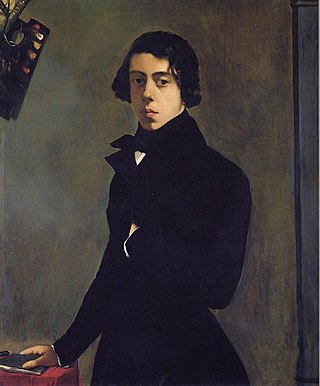
Théodore Chassériau was a Dominican-born French Romantic painter noted for his portraits, historical and religious paintings, allegorical murals, and Orientalist images inspired by his travels to Algeria. Early in his career he painted in a Neoclassical style close to that of his teacher Jean-Auguste-Dominique Ingres, but in his later works he was strongly influenced by the Romantic style of Eugène Delacroix. He was a prolific draftsman, and made a suite of prints to illustrate Shakespeare's Othello. The portrait he painted at the age of 15 of Prosper Marilhat makes Chassériau the youngest painter exhibited at the Louvre museum.

The Church of Saint-Sulpice is a Catholic church in Paris, France, on the east side of Place Saint-Sulpice, in the Latin Quarter of the 6th arrondissement. Only slightly smaller than Notre-Dame and Saint-Eustache, it is the third largest church in the city. It is dedicated to Sulpitius the Pious. Construction of the present building, the second on the site, began in 1646. During the 18th century, an elaborate gnomon, the Gnomon of Saint-Sulpice, was constructed in the church. Saint-Sulpice is also known for its Great Organ, one of the most significant organs in the world.

Henri-Jean Guillaume "Henri" Martin was a French painter. Elected to the Académie des Beaux-Arts in 1917, he has been described as a prolific master whose work has touches of melancholy, dreaminess and mystery.
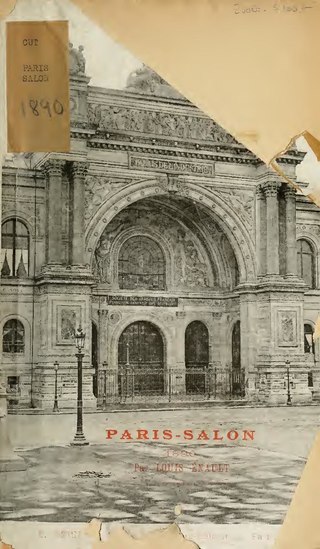
Société Nationale des Beaux-Arts was the term under which two groups of French artists united, the first for some exhibitions in the early 1860s, the second since 1890 for annual exhibitions.
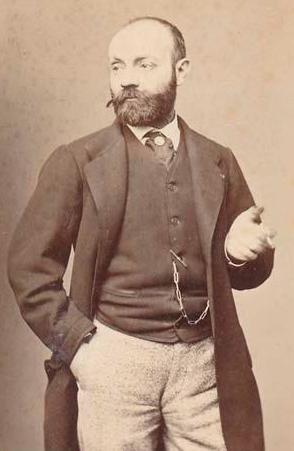
Gustave Clarence Rodolphe Boulanger was a French figurative painter and academic artist and teacher known for his Classical and Orientalist subjects.

Auguste-Barthélemy Glaize (1807–1893) was a French Romantic painter of history paintings and genre paintings.

The Musée national Eugène Delacroix, also known as the Musée Delacroix, is an art museum dedicated to painter Eugène Delacroix (1798–1863) and located in the 6th arrondissement at 6, rue de Furstenberg, Paris, France. It is open daily except Tuesday; an admission fee is charged.

Victor-Louis Mottez was a French fresco painter, painter and portraitist.
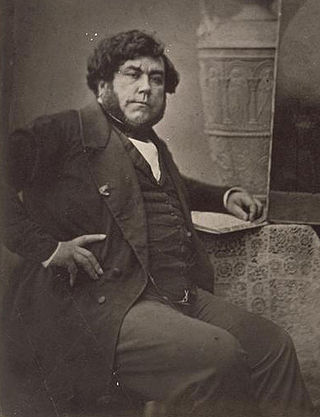
Jules-Claude Ziegler (1804-1856) was a French painter, ceramicist and photographer of the French school.

Louis Antoine Léon Riesener was a French Romantic painter.

Édouard Joseph Dantan was a French painter in the classical tradition. He was widely recognized and successful, even receiving grudging respect from a contemporary Modernist painter and critic Walter Sickert.
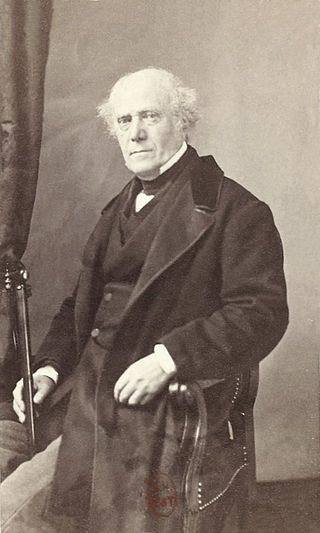
Nicolas-Auguste Hesse was a French painter and lithographer. He produced historical, mythological, religious and allegorical works along with portraits, wall paintings and designs for stained glass windows.

Jean-Édouard Dargent, known as Yan' Dargent and in his later years Yann Dargent, was born in Saint-Servais on 15 October 1824 and died in Paris on 19 November 1899. He was a French painter and illustrator. Most of his paintings depicted Brittany.

Atelier de la rue Furstenberg is an 1866 oil-on-canvas painting by the 19th century French impressionist artist Frédéric Bazille, which has been in the collection of the Musée Fabre in Montpellier, France since 1985.

Eugène de Malbos was a French Romantic painter known for his lithographs of the Pyrenees.

Eugène Goyet, was a French artist. Beginning in 1827 his work was regularly selected for exhibition in the annual Paris Salon. He achieved his greatest success as a painter of religious subjects, with his paintings of Christ and various saints installed in churches and public buildings across France. A successful portrait painter, his most prestigious commission was his 1847 portrait of Pope Pius IX. He was the son of self-taught artist Jean-Baptiste Goyet, and husband of the pastel portrait artist Zoé Goyet.